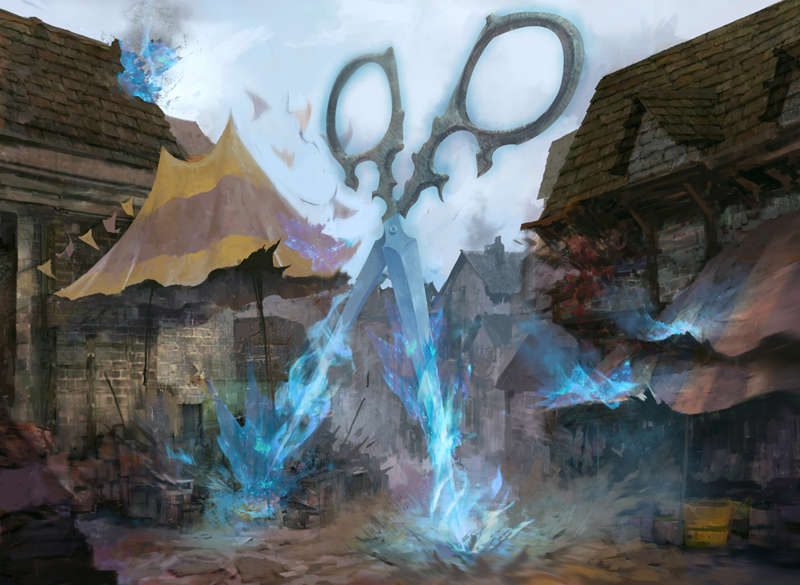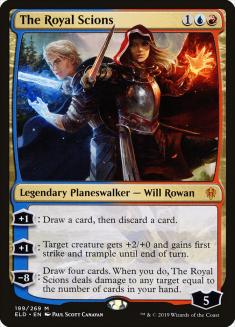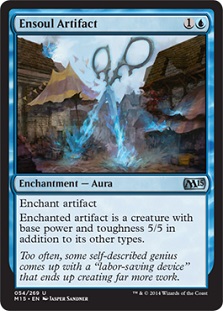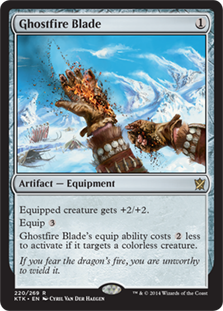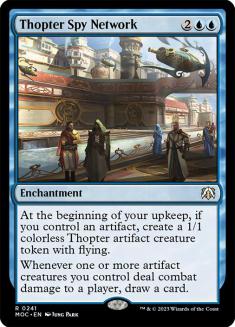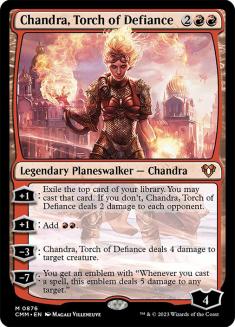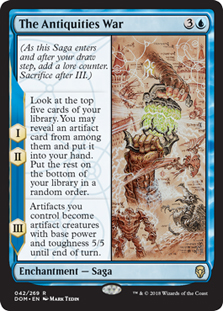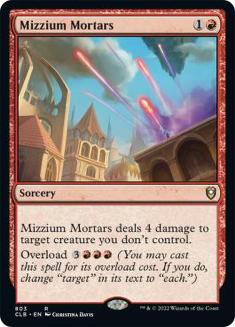Pioneer on the cusp of the European and Japanese Players Tour events is in a relatively healthy, dynamic place. After a relatively small number of bans, the format has settled down with two monocolored aggro decks (Mono-Black Aggro and the oddly named Big Chonky Red), two control decks (Five-Color Niv-Mizzett and Azorius Control), and two multicolored aggro decks (Izzet Ensoul and Azorius Spirits). There are also a few wild combo decks on the fringe of the format, with Golgari Soulflayer, Underworld Breach, Dimir Inverter, and (of course) various Heliod, Sun-Crowned and Walking Ballista midrange-combo shells showing potential signs of life.
In any given round, I would not be surprised to play against any one of over a dozen unique archetypes, which means that (at least for now) Pioneer is not in dire need of immediate action. The format simply hasn’t had time to evolve to an end-stage where one deck dominates, and these PTs are effectively the debut of Pioneer as a full-fledged format.
But there is an interesting wrench being thrown our way in the lead-up to the Players Tours. Because of the staggered dates for the different regional PTs, we are in a unique situation. Those who choose to play in the earlier events have more informational asymmetry between the well-prepared and the not-so-well-prepared. By the time another week rolls around, we’ll have so much more information to use in selecting a deck, it will even out the playing field and dramatically reduce the chance of anyone “breaking it” for Phoenix.
As such, players competing in the American PT would be best served picking a deck that they enjoy, practicing with it to familiarize themselves with common play patterns, and then devoting the rest of this week to practicing Limited before adjusting based on the results of the two other PTs. European and Asian players, on the other hand, are squeezed and incentivized to frantically try everything in an attempt to break the format on Week 1.
For those preparing for Limited, Sam Black article on Theros Beyond Death Draft is the best piece of content available. For Pioneer, though, it’s imperative to break down the players and deep dive on some of the underappreciated archetypes that stand to bump up to the next level come next week.
Just as Mono-Black Aggro was immediately thought to be too badly weakened after the banning of Smuggler’s Copter to remain competitive, so too was Izzet Ensoul. Of course, it was never about the Copter for Mono-Black; it was about playing the best one-drop spells and having the best manabase in Pioneer. Izzet Ensoul doesn’t have nearly the same level of natural consistency as Mono-Black Aggro, but its power level is quite high and it can win the game out of nowhere.
It’s worth a second look, and Mattia Rizzi’s list from last week is exactly where I would start.
Creatures (20)
- 4 Bomat Courier
- 2 Hope of Ghirapur
- 4 Skilled Animator
- 2 Emry, Lurker of the Loch
- 4 Gingerbrute
- 4 Stonecoil Serpent
Planeswalkers (2)
Lands (22)
Spells (16)

The Royal Scions did not replace Smuggler’s Copter. That would be impossible. What it did do, though, was provide a bridge to a slightly more consistent long-game deck despite not offering quite as many direct synergies with the Skilled Animator / Ensoul Artifact pieces. This “bridging” effect in an aggressive deck is not the most common piece of deckbuilding innovation, but when it comes around it can easily take a one-dimensional deck and make it into a monster.
Previous examples of this effect are when Restoration Angel was printed and allowed Azorius Delver decks in Standard to maindeck a card that then incentivized them to run a full control juke in the sideboard. With only fifteen sideboard cards, it had not been possible to fully shift to a control deck. With a maindeck-quality card that also contributed to a controlling gameplan and meshed nicely with sideboard plans, Delver was able to sideboard all the way up to Day of Judgment and Consecration Sphinx.
Similarly, Bant Heroic decks in Khans of Tarkir Standard added another level of utility after Magic Origins came out when they pulled in copies of maindeck Hangarback Walker and Den Protector. Suddenly post-sideboard they could eliminate the majority of the Heroic aggro-tempo plan and turn into a resilient and grindy midrange deck with those Hangarback Walkers, looping Den Protectors, Treasure Cruises, and even Tragic Arrogance.
The Royal Scions has the potential to do the same thing for Izzet Ensoul. It’s not as aggressive as Smuggler’s Copter. It’s not even close to as powerful simply on rate. But it offers looting, it offers pump, and it offers an end-game. It is a maindeckable tool that allows for a more cohesive and consistent sideboard shift over to grindy cards like Thopter Spy Network, Hangarback Walker, and Chandra, Torch of Defiance.
Part of the beauty with Izzet Ensoul right now is that … it’s underrated and looks like the kind of deck a weak player would use to cheese out a stronger opponent.
And yes, that looting effect is definitely necessary in a deck that attempts to combine something from column A (in this case, the one-drop artifacts or a Darksteel Citadel) with something from column B (Ensoul Artifact, Skilled Animator, and Ghostfire Blade to a lesser extent). But The Royal Scions also sets up a three-turn ticking time bomb, with an ultimate that draws a bunch of cards and shoots something for five or more damage. The games where you ultimate this planeswalker and still lose are few and far between.
The most important strategic skills to learn for a deck like this, then, are mulliganing and sideboarding for each matchup. You’re like an Affinity deck in Game 1, and then have the option of turning into a weird Fish deck or midrange deck for the second and third games.
For starters, your best hands involve suiting up a Darksteel Citadel and going to town with an indestructible 5/5. If the opponent is removal-light (or simply doesn’t have Fatal Push), then suiting up a Stonecoil Serpent can be even better.
Your next tier of hands involve one or more Ghostfire Blades. Multiple Ghostfire Blades can make even the humble Gingerbrute an unblockable monster. If the opponent is removal-dense, your Ghostfire Blade draws are better than your Ensoul Artifact or Skilled Animator draws.
Beyond that you’re going to mulligan your seven-card hands. You will most likely not keep a seven-card hand if you have no Ghostfire Blade, Skilled Animator, or Ensoul Artifact. It’s simply going to be too difficult to punch through enough damage to win the game.
You can easily win off a mulligan to six or even five, since a scissor-wielding Darksteel Citadel beats almost everything by itself.
Lastly, you still need to have a target for your payoff cards, so any hand without a cheap artifact to suit up is not worth playing on seven. One-drops are key!
Once you’re looking at your third opening hand, though, you may have to loosen up your requirements. A hand of Bomat Courier, Wild Slash, two lands, and an Emry, Lurker of the Loch is probably good enough to keep despite missing an Ensoul Artifact. You start looking for any reasonable incentive to keep once you get down to five cards. That could mean looking down at two Wild Slashes and The Royal Scions and hoping to win off the back of the powerful planeswalker, or even just a mix of lands and spells with one or two Bomat Couriers to hope to get lucky and refuel in the mid-game.
With the London Mulligan, Bomat Courier, and the wide disparity between your good draws and your bad draws, it behooves you to mulligan aggressively in Game 1.
Sideboarding
That all changes, though, once sideboards get involved.
Assuming you cut some of your weaker individual cards for a given matchup, you will either turn into a Fish deck with Stubborn Denial and Disdainful Stroke or a midrange deck with Aethersphere Harvester, Abrade, Thopter Spy Network, and Chandra, Torch of Defiance. If your opponent is on an interaction-light combo deck, you will probably cut Wild Slash and Emry, Lurker of the Loch for countermagic. If they’re a control deck with few threats, you can cut your removal for countermagic and powerful late-game plays and hammer them with threats.
And if they’re interaction-heavy, then it’s time to get rid of Hope of Ghirapur and some of your payoff or interaction cards (Shrapnel Blast, Wild Slash, Skilled Animator) and bring on the grindy half of the sideboard.
In these games, frequently against the aggro decks of the format, you will know that they have brought in more removal in an attempt to break up your synergies. Abrade out of Chonky Big Red. Disfigure, Infernal Reckoning, or Liliana, the Last Hope out of Mono-Black Aggro. You’ll want to hunker down behind a Hangarback Walker or an Aethersphere Harvester and try to trade positively while keeping the battlefield relatively balanced, winning with a top-end self-contained gameplan card.
That might be Thopter Spy Network; it might be Chandra, Torch of Defiance; and it might even be The Antiquities War or an overloaded Mizzium Mortars in some sideboards. You might also draw enough copies of Ghostfire Blade to enable you to pass around the Equipment and make both an unblockable attacker and an unassailable blocker, winning through sizing superiority.
The fact is, your creatures are so threatening with the potential of a random Equipment or enchantment making them huge, and even more threatening from a psychological perspective of the average opponent, that you may be able to wring a bit of false tempo out of your sideboard plans. If opponents reduce their speed and increase their interaction with their sideboards, you can walk them into a trap where they plan on making the game go long without realizing that they are no longer the beatdown in the matchup.
It’s a phenomenon that happens with Mono-Black Aggro when it sideboards into a midrange removal-heavy deck with flood protection from Mutavault and Castle Locthwain, but it’s less obvious and thus more ripe for exploitation in Izzet Ensoul.
After all, what happens when an opponent with a hand bursting with Fatal Pushes and Infernal Reckonings has to watch as you cast The Royal Scions and Thopter Spy Network? Sharp opponents will realize they’ve been had, and try to get a little more proactive in the future. Others will get frustrated and blame something like your luck in drawing your sideboard cards or their own bad luck.
Part of the beauty with Izzet Ensoul right now is that, because it’s underrated and looks like the kind of deck a weak player would use to cheese out a stronger opponent, it’s not quite in the crosshairs of the average Pioneer player as an archetype to prepare for outside of the basic sideboard plan for an aggro deck. This is exactly why you want to play it. Not only is there a ton of free equity to pick up because the deck has a high top decile of draws and a fast goldfish, but there’s more free equity lying around from opponents who underestimate you, miss the sideboard juke, get mixed up with the wrong role assignment, and take a loss.
Like Affinity in old Modern, Izzet Ensoul offers a high floor for a newer, less experienced player. You can memorize an algorithm for your mulligan decisions and get most of the way to perfect, practice a few common play patterns, and pick up some wins with raw speed and power. But also like Affinity, a master can squeeze quite a lot of wins out of rags, and can sideboard in such a way that they leave opponents scratching their heads. It’s worth investing in and mastering for the long run.

